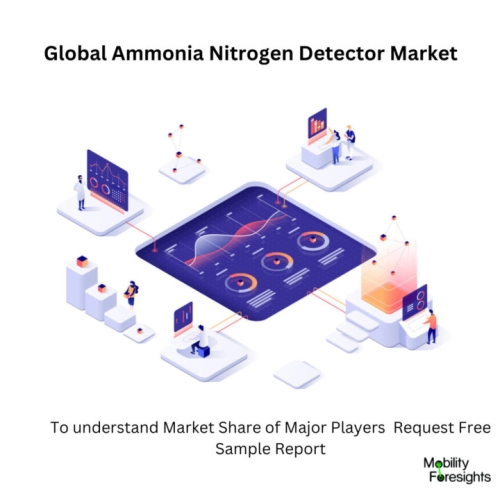
- Get in Touch with Us

Last Updated: Apr 25, 2025 | Study Period: 2024-2030
A tool used to identify ammonia in a sample is an ammonia nitrogen detector. Ammonia is a typical consequence of decomposition and is frequently discovered in environmental samples such as wastewater and industrial effluent. High concentrations of it have the potential to be harmful to aquatic life, and if inhaled or consumed by humans, it poses a risk to their health.
Ammonia nitrogen detectors come in a variety of forms, such as colorimetric test kits, electrochemical sensors, and optical sensors. Colorimetric test kits are straightforward and affordable, however they might not be as precise as other kinds of detectors.
Whereas optical sensors employ light to detect the presence of ammonia and can be used in real-time monitoring applications, electrochemical sensors are more expensive but can provide more accurate results.
In environmental monitoring applications, ammonia nitrogen detectors are frequently used to make sure that ammonia levels are within permissible bounds. Additionally, they can be used in industrial settings to monitor wastewater or effluent in order to stop pollution and guarantee that environmental rules are being followed.

Global ammonia nitrogen detector market accounted for $XX Billion in 2023 and is anticipated to reach $XX Billion by 2030, registering a CAGR of XX% from 2024 to 2030.
Novel Ionic-Based Sensors for Detecting Ammonia nitrogen gas.They have successfully developed and commercialised a range of long-life ammonia sensors based on ionic technology by using sophisticated materials and rigorous design optimization.
Because of the non-consumptive nature of this technology, the sensors can function well in environments where ammonia is present either continually at low levels or accidentally released.
This technology, especially for extreme settings like industrial refrigeration applications, allows operation down to -40 Deg C and provides accurate and dependable ammonia gas detection.There are ranges up to 5000 PPM available. The short lifespans and limited maximum range of the market's current disposable ammonia sensors are finally addressed by this new product line.
They offer these sensors in a variety of configurations, including sampling detectors, safe area (non-ATEX), and ATEX-rated devices. For your application, a variety of accessories are available, including probes, adaptors, and splash and dust guards. Their gas detection systems are compliant with BS EN 378 and BS EN 45544 and have passed testing to BS EN 60079-29-1.
| Sl no | Topic |
| 1 | Market Segmentation |
| 2 | Scope of the report |
| 3 | Abbreviations |
| 4 | Research Methodology |
| 5 | Executive Summary |
| 6 | Introduction |
| 7 | Insights from Industry stakeholders |
| 8 | Cost breakdown of Product by sub-components and average profit margin |
| 9 | Disruptive innovation in theIndustry |
| 10 | Technology trends in the Industry |
| 11 | Consumer trends in the industry |
| 12 | Recent Production Milestones |
| 13 | Component Manufacturing in US, EU and China |
| 14 | COVID-19 impact on overall market |
| 15 | COVID-19 impact on Production of components |
| 16 | COVID-19 impact on Point of sale |
| 17 | Market Segmentation, Dynamics and Forecast by Geography, 2024-2030 |
| 18 | Market Segmentation, Dynamics and Forecast by Product Type, 2024-2030 |
| 19 | Market Segmentation, Dynamics and Forecast by Application, 2024-2030 |
| 20 | Market Segmentation, Dynamics and Forecast by End use, 2024-2030 |
| 21 | Product installation rate by OEM, 2023 |
| 22 | Incline/Decline in Average B-2-B selling price in past 5 years |
| 23 | Competition from substitute products |
| 24 | Gross margin and average profitability of suppliers |
| 25 | New product development in past 12 months |
| 26 | M&A in past 12 months |
| 27 | Growth strategy of leading players |
| 28 | Market share of vendors, 2023 |
| 29 | Company Profiles |
| 30 | Unmet needs and opportunity for new suppliers |
| 31 | Conclusion |
| 32 | Appendix |